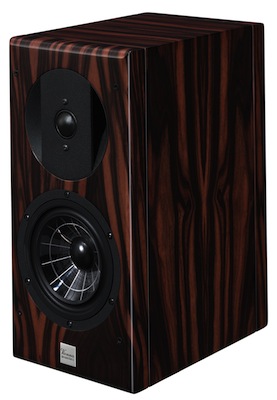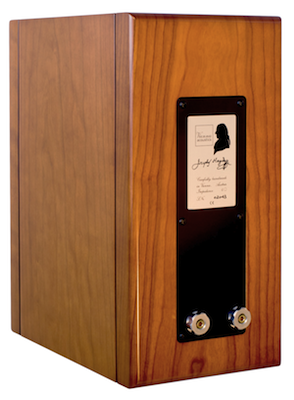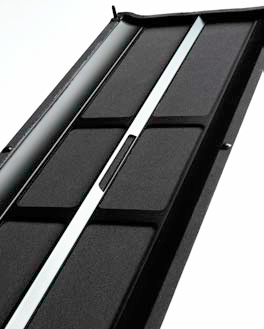Vienna Acoustics Haydn
Gemütlichkeit
To begin, a confession: I’ve always preferred full-range speakers. More specifically, I’ve always sought speakers that can reach down to 20 Hz, or close to it. No matter that much of the music I listen to doesn’t drop much below 40 Hz, the issue for me has traditionally been one of theoretical capability. Back in 1976 when I acquired my first “serious” gear, I carefully researched speaker frequency response before choosing ElectroVoice Interface: A speakers, due in no small part to the fact that they could reach down to the mid-twenties. (I’ve recently had these speakers refurbished, by the way, and am astonished at how good they sound 35 years on…but this is a story for another day.)
At a point in time, sadly, reality kicks in: The rooms in our house in London are too small to comfortably fit some of my larger speakers, and even if they could, the Wife Acceptance Factor of my reference speakers is exceedingly low. A couple of years ago I spent a day with a friend in Hong Kong visiting high-end stereo showrooms. In one a pair of Haydn Grands was playing (some vocal tracks, if I recall correctly). I was struck by the sound, and by the look of the speakers (and the transparent drivers) and the memory stayed with me. So it was a short putt to contact Kevin Wolff at Vienna Acoustics who put me in touch with Audyus Distribution to arrange a review sample.
A pair of Haydn Grand SEs (“Special Edition”) appeared shortly after; these were a newer version of the speaker than the ones I had heard in Hong Kong…and they were a short-term production run of 500 speakers featuring walnut veneer and special Haydn-themed badging. These were superseded by the “Symphony Edition” models: Functionally identical to the SEs, and likewise fully shielded, but available in different finishes (Piano Black, Maple, Cherry and a very fetching Rosewood veneer).


Physical Presence and Construction
The first thing that struck me about the Haydns was physical: These are jewel-like speakers, very modest in size (just 14” high and 7” wide), but perfectly formed: The veneer is gorgeous, and wraps around all six sides of the mini-monitor, included the rounded surfaces that link the top, bottom and sides of the speaker to the front baffle (which is a massive 1 1/4” thick). The shape makes you want to touch them, and the detailing is impressive: Binding posts feature large knurled knobs that connect directly to the crossover within, an attractive black fabric grille (with a trick up its sleeve…more on that later), integrated fittings to couple the speaker to a stand. Clearly great thought went into design as well as execution. The Haydn’s are unobtrusive: Conservative in appearance, they do not scream “Look at me!”. Nonetheless, you will want to look at them.
The driver complement is typical of mini-monitors, though the actual drivers used are not. Like all of Vienna Acoustics’ drivers (save the woofer in the Mahler), the drivers in the Haydn are proprietary. Vienna Acoustics makes the cones in Austria and then works with companies like ScanSpeak, Seas and Eton to do final driver assembly.
Lower frequencies are handled by a six-inch mid/woofer, composed of Vienna Acoustic’s proprietary X3P transparent plastic material, and a one inch silk-dome tweeter. The mid/woofer’s material is a reformulation of what used to be called XPP material. As the manufacturer puts it, “combining TPX, the unique thermoplastic used in all XPP cones, with three polypropylene based synthetics achieves maximum inner damping, ultra-low mass, and precise control over cone density and rigidity.” The material is called X3P as a result of the three additional polymers used in its formulation.
The Haydn’s “triple stacked” tweeter is of the silk-dome variety with an ultra-light voice coil and a ferrofluid-based damping system. The crossover features MKP capacitors, air coils and metal film resistors. The manufacturer’s use of modified first order crossovers puts meaningful stress on the tweeter. Specifically, this type of design forces the tweeter to be able to play lower in frequency than a more steep design. For this reason a much larger magnet assembly is required. In order to fit this tweeter in the tuning block of the port, Neodymium was a logical choice. However, the basic designs out there were not strong enough – thus a larger structure.
The Haydn is a ported design, but with a port that is unusual: Rather than being located at the back of the cabinet (where it can interact unfavorably with rear walls), or by itself on the front baffle (where it requires additional speaker height), the port is located above the mid/woofer, and the tweeter is suspended in the mouth of the port. Vienna Acoustics calls this the “air-flow control wedge” and it works exactly as advertised, resulting in extended bass performance and a reduction in port noise. With the tweeter in the mouth of the port, phase coherence is improved and the speaker behaves more like a point source design. The port/wedge construction is of heavy gauge aluminum, consistent with the general construction of the speaker.
One of the “surprise and delight” features of the Haydns is the grille, a component that is often an afterthought, even on high-end speakers. The black mesh grille, which fixes to the front of the speaker via a pin/receptacle arrangement, is arrayed on an aluminum frame that features a V-shaped phase diffuser running vertically down the center of the grille. Perforated where it passes in front of the tweeter, this phase diffuser is meant to control dispersion when the grille is in place. Vienna Acoustics suggests that it be left in place for all but the most critical listening. I found that the speakers, particularly the high frequencies, were more realistic with the grilles removed, but replacing the grilles did much less damage than they do with most speakers I’ve heard. It’s an elegant design touch.

Listening
The speakers were new when I received them, and the bass response was accordingly a bit “tight”. After about 100 hours of break in the speaker began to sound fuller and more integrated, and my comments that follow refer to the sound after break in.
My immediate impression upon hearing the Haydns was one of musicality. To say that any speaker sounds “like music” is cliché, however having listened to more than a few speakers in my years, the Haydns seemed—more than many speakers—to disappear and let the music through. As one might imagine with a mini-monitor, the Haydns excel at reproducing vocals (particularly the female voice) but are also excellent at reproducing acoustic music, whether guitar, chamber music or unamplified jazz. I’ve been listening to a number of the Blue Note vinyl reissues from both Music Matters and Acoustic Sounds (these are as close to “reference” vinyl as it is possible to be). The Haydn Grands handled the complex hard bop beautifully; instrumentation was clear and individualized, and the speakers successfully interpreted the music’s emotion.
More relaxed jazz was also a forté of these speakers. Given the season, I cued up the Analogue Productions 45 RPM reissue of Vince Guaraldi’s soundtrack to A Charlie Brown Christmas. Piano, bass, percussion, all were reproduced with a delicacy and fidelity that are class-leading.
High frequencies are determinedly “non-audiophile”, and I mean that in a very positive way. Too many speakers pitched at the high end accentuate high frequencies in a way that sounds at best too forward, and at worst etched or artificial. The Haydns’ high frequencies simply sound realistic: Neither soft, nor accentuated. Bill Evans’ tribute to Scott LaFaro, Sunday at the Village Vanguard (the extremely well-produced Riverside CD box set) features fantastic brushwork on Paul Motian’s cymbals. Through the Haydns this brushwork neither dominated, nor faded into the background.
As noted above, the Haydns did a wonderful job with voices. In fact, the midrange reproduction of these speakers is marvelous. The relatively small mid/woofer handles the majority of the midrange duties, but the integration with the tweeter is seamless…thank you Mr. Crossover. I’ve been listening heavily to female voices of late: Ella Fitzgerald, Billie Holiday, Norah Jones, Julie London, Madeleine Peyroux and others. The speakers move easily from breathy to belting, and back again.
The greatest surprise in the performance of these speakers in their ability to reproduce bass frequencies, which meaningfully belies their size. I’m not talking about the lowest register of the organ (which any small speaker will struggle—and fail—to reproduce), but rather the frequencies just below core midrange frequencies. In conjunction with this—and perhaps because of this—these speakers did a fine job of appearing larger than they are. My taste in classical music runs to large-scale orchestral and choral works, and while Carmina Burana (Telarc vinyl) and Mahler’s Symphony #2 (recently-released San Francisco Symphony SACD) won’t blow you out of your chair through the Haydns, they nonetheless go a long way toward the “you are there” moment. Kudos to Vienna Acoustics’ mid-woofer.
On this point, the Haydns are reasonable efficient, at 89 dB efficiency. The manufacturer suggests at least 25 wpc to drive them, but in my view you will want to feed them much more power, and via an amplifier that can deliver decent current. The 500 wpc that I used is clearly overkill, but I recommend that you should have at least 100 watts per channel on hand to get the best from these speakers.
These speakers are capable of throwing a large soundstage, and their precision allows the listener to pick out instruments in space. As with most mini monitors, the Haydns are best used on stands; for critical listening I placed the speakers on a pair of Vienna Acoustics branded stands. These stands are heavy, stable platforms that are purpose-built for these speakers, and feature bolt holes that match exactly with the fittings on the bottom of the Haydns. As with most mini-monitors, stands are essential if you want to extract the maximum from the speakers. Bookshelf or (horrors) floor placement results in a collapse of the soundstage and high frequency suppression. Listening with the speakers on stands, and tweeters at or about ear level, is the call. The Vienna Acoustics stands have been discontinued, but the UK distributor recommends using any good quality stand with a height of around 28 inches/70 centimeters.
Conclusions
Gemütlichkeit connotes feelings of cheerfulness, security and relaxation. It brings with it the opportunity to spend quality time. This expression defines these speakers. The Vienna Acoustics Haydns are beautiful to observe, sumptuously built and finished, and perform far better than their diminutive size would suggest. They marry an ability to get at the core of the music that they reproduce and avoid the “bass shy and treble harsh” stereotype of the “audiophile” mini monitor. While there are many options from which to choose at this price point, I would argue that the Haydn represents a “best buy” in the category. Buy some stands, and ensure that you have adequate amplification, and you will find that these are speakers with which you can live happily ever after.
Specifications
- Impedance: 4 Ohms
- Frequency Response: 42-20,000 Hz
- Sensitivity: 89 dB
- Recommended Amplifiers Drive Units: 25-180 watts RMS
- 5” Bass/Midrange Driver: X3P Cone, Transparent
- 1 ” Dome-Tweeter: Hand-coated VA Silk Dome
- Bass System: Bass Reflex, Front Ported
- Bass Function: Impulse Optimizing QB 3 (Quasi-Butterworth)
- Crossover Components: MKP Capacitors 1% Tolerance
- Coils 0,7% tolerance, Exclusively Air Coils
- Metal Film Resistors, 1% tolerance, Inductance Free
- Crossover Function: 2-way, 6 dB and 12 dB Bessel
- Weight per Pair: 44 lb / 20 kg
- Dimension (W x H x D) inches: 6.85 x 14.2 x 10.4“
- Dimension (W x H x D) mm: 174 x 361 x 265 mm
Serial Number of Equipment Reviewed: 217 (both speakers)
Availability and pricing
Manufacturer
V.A. Lautsprecherproduktion GmbH
Rysergasse 60
1230 Wien, Austria
www.vienna-acoustics.com
UK Distributor
AUDYUS Distribution
Ermine Business Park , Huntingdon
Cambridgeshire PE29 6XY
www.audyus.co.uk
US Distributor
Vienna Acoustics—North America Inc.
728 Third Street, Unit C
Mukilteo, WA 98275
www.vienna-acoustics.com
Price: US$1,800/UK£1,200 per pair
Review Equipment
- VPI Classic 2 Turntable with SDS Power Supply
- Benz-Micro Glider SL Cartridge
- Musical Surroundings NovaPhonomena Phono Preamplifier
- Gallo Reference 3.1 speakers
- McIntosh C712 preamplifier
- Yamaha MX-D1 stereo power amplifier
- Sony XDR-F1HD tuner
- Shanling SCD-T200 SACD player
- Logitech Squeezebox Touch Streamer
- Cambridge Audio DAC Magic
- Mapleshade speaker wire, Blue Jeans speaker cable and interconnects, Ultimate Cables, AudioQuest, ProSolutions and AR interconnects




Very nice review–I’d love to hear these! I have a pair of mini monitors (not nearly as nice, SA505) and it’s really surprising how great smaller monitors can sound with the proper equipment and the construction by the right company really makes all the difference too.
Dude where are my speakers!! Diffraction Felt Tweeter Surrounds WOW !!!
« on: 9 Oct 2007, 10:26 PM »Quote:
“OK, I ordered some felt tweeter surrounds from diffractionbegone.com for my Vienna Acoustics Haydn’s. Spoke to Jim and he sounded like the real deal AND he offered all AC members a special price of 29.95 a pair for the felt tweeter surrounds.
Just got them today and WOW!! They really work.
After 3 songs this is what I hear.
My speakers disappear, imaging improves… alot
Sound is way more natural, piano has weight, drums have weight(strange)
I did a high volume job on a song that can get a bit rough and WOW handled it with ease and it sounded so natural. Maybe it is system dependent but damn I am ordering another pair for my GR research av2’s. Very clean and natural warm sound. So real!
Give it a try, we spend hundreds on tweaks here is a cheap one that I think works, if you don’t like it send it back for a full refund… let’s see the magic clock, or colored pebbles in the corner tweak do that!!!
Just some preliminary thoughts…..more to follow.
Mike”
This was the first published review that diffractionbegone.com, my small enterprise, got, and it happens to be using Haydn’s. So, I thought I might be able to sneak in his review. There have been many positive reviews since, it pleases me to say. A little bit of love for owners of speakers with right or near right angles from me to you.